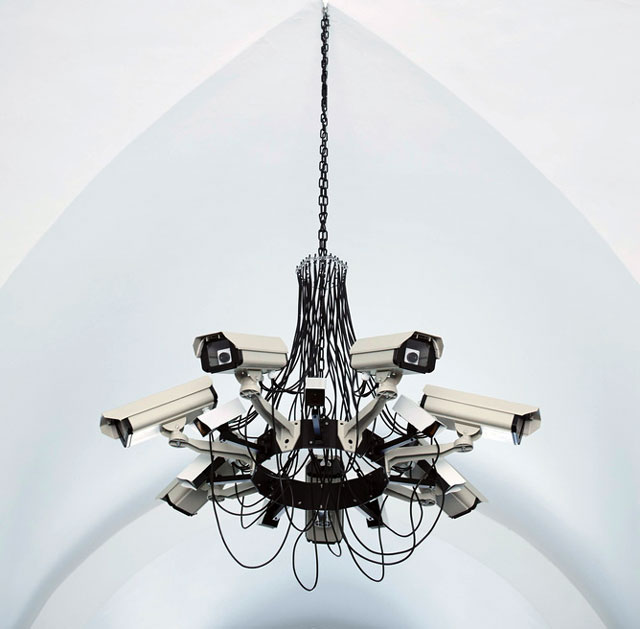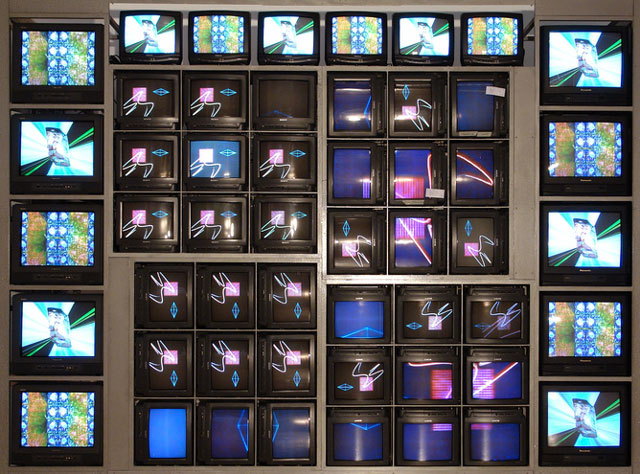
How has the Internet changed art? It is this ambitious question that an exhibition enticingly named Electronic Superhighway (2016-1966) at the Whitechapel Gallery in London sets out to answer.
The exhibition takes you through a reverse chronology of major digital and Internet-themed artworks. We begin in the present before being transported along a helter-skelter tour into the past, all the way back to 1967 when Bell Laboratory began sponsoring collaborations between artists and technologists. These collaborations coincided with the birth of the Internet. In 1968, the first packet-switching network, Arpanet, went online, and formed the technological foundation of the modern Internet.
The show is remarkable in its breadth. Its historical journey encourages reflection on the rapidly accelerating development of our information-heavy society and its social, economic and political consequences.
The exhibition begins with the most banal of images: a blown up picture of a female bottom with SMS bubbles streaming out of it. Olaf Breuning’s Text Butt is quite literally talking out of its arse, perhaps a cheeky riposte to the art critics assembled before it. It’s also an immediate reminder that though the culture of the Internet is increasingly celebrated as art, most of it remains trivial.
Banality is a running theme through many of the contemporary pieces in the opening section of the exhibition — James Bridle’s airport-style hologram, Homo Sacer, for example, drones out the securocratic bromides of the national security state. Of course, this also begins to suggest a darker side to the mundaneness of our technological age.

Douglas Coupland, renowned author of Generation X, and Trevor Paglen, famed for his long-exposure photographs of NSA facilities, develop that darker side still further with ruminations on the corporate and state surveillance of the Internet. Deep Face, Coupland’s series of portraits with the faces blocked out by Mondrian-like abstractions, are a protest (we are told) against Facebook’s development of facial recognition software. Paglen highlights both the problem of, and solution to, state surveillance. His map of NSA-tapped undersea Internet cables hangs behind his Autonomy Cube, a working Wi-Fi hotspot that routes all traffic through the anonymous Tor network.
As you make your way back in time through the exhibition, it is striking how the paranoia and banality inspired by the Internet of today contrasts with the early optimism that initially greeted it. This retrospective view encourages reflection upon the broken promises and lost opportunities for social and political change that the early Utopian impulse of an interconnected world conveyed.
The fulcrum of the exhibit sets two works against each other to bring this home. The technological sublime of Nam June Paik’s 1994 video installation Internet Dream contrasts sharply with the voyeuristic, even pornographic resonances of Jill Magid’s Surveillance Shoe (2000).
Though only six years apart, an epoch divides them. The former was created amid the boom years of the World Wide Web’s still nascent emergence. The latter was produced during the bursting of the dot-com bubble that coincided with the early development of many of the tools (such as Total Information Awareness) that laid the foundations of the 21st century surveillance state — a period and a subject dealt with masterfully by Thomas Pynchon in his latest novel.

Walk past Magid’s shoe and we’re back to the future of the Internet’s innocent first decades. The final few rooms conjure the sense of discovery and possibility that the early Internet rendered. Abstract experiments in technique and form by Tony Longson and Frieder Nake, among others, are indicative of that sense of possibility that came with the emergence of an entirely new medium.
One of the final exhibits is a poster of the 1968 Cybernetic Serendipity exhibition. Its slogans promise “happy chance discoveries” generated by the meeting of human and machine in an “exhibition demonstrating how man can use the computer and new technology to extend the scope of his creativity and inventiveness”. Despite its techno-futuristic design, its cheerful language and unfettered optimism about computational technology betray it as an ancient relic of a bygone age when sexting, Ashley Madison hacks, “Tempora” mass surveillance programmes and all the detritus of our digital age were not foreseen.
Turn around and walk back through the exhibition — returning progressively to the present — and you experience the rapid evaporation of that “cybernetic meadow” described by Richard Brautigan in 1967:
where mammals and computers
live together in mutually
programming harmony
like pure water
touching clear sky.
Leaving the exhibition, I looked up and noticed Addie Wagenknecht’s steel chandelier of CCTV cameras watching over us, which I’d missed on the way in. And then just outside the gallery, on the short walk back to Aldgate tube station, I spotted a configuration of cameras as elaborate and evocative as any of the artworks I’d just seen. Only I wasn’t in the safe space of an art gallery anymore, I was back on the streets of one of the most surveilled cities on the planet.
How has the Internet changed art? Perhaps it would be more accurate to say that the Internet has changed us — our lives, relationships, careers, governments, morals, language, communities — and art has changed with them.![]()
- Simon Willmetts is lecturer in American studies at the University of Hull
- This article was originally published on The Conversation

